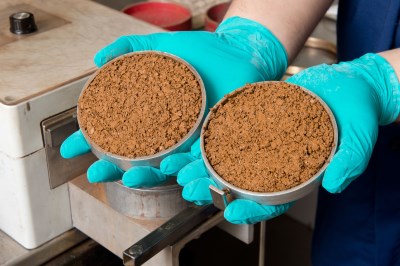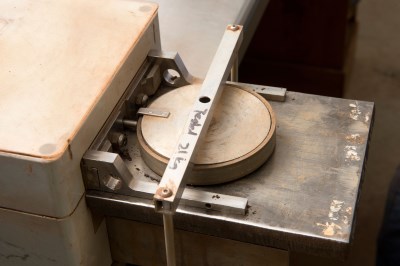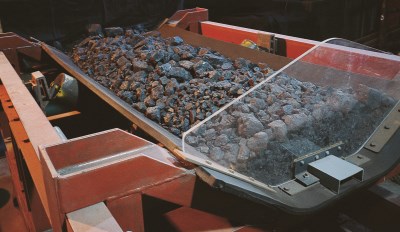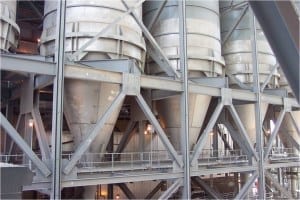Services List
-
Services By Handling Problems

Flow Properties Testing
The design of handling and storage facilities requires knowledge of the behaviour and flow properties of the bulk solids under operating conditions.
Conditions include loading and consolidation for instantaneous and extended time storage as well as environmental factors such as temperature, moisture and humidity.
There are well established laboratory test procedures for determining the necessary flow properties which allow calculation and assessment of storage facility design parameters. The type and range of tests required depend on the moisture content, particle size range, application and type of storage facility to be designed or assessed.
TUNRA flow properties tests are typically performed in the -4mm size fraction using a Jenike style shear testing machine. These tests determine the bulk strength and internal friction angles as functions of major consolidation stress for the bulk material.

Low Consolidation Testing
Measurements of material properties at low consolidation pressures, including determination of compressibility and wall friction characteristics, allows calculation of design parameters to define the basic geometry of mass flow hoppers.
High Consolidation Testing
When designing gravity reclaim stockpiles or large funnel flow storage bins, higher consolidation pressures need to be considered. Measurement of the bulk strength at high consolidation allows calculation of draw-down angles and critical rathole dimensions for use in stockpile, expanded flow and reclaim bin design.
Determination of Worst Case Moisture Content
The strength of bulk materials typically increases with the addition of moisture and reaches a peak at some point beyond which additional moisture generally reduces the bulk strength. This point, at which maximum strength is achieved, can be determined to enable design for worst case conditions.
Testing with Undisturbed or Vibrated Storage Time
Many bulk materials gain cohesive strength and change in flow behaviour when left undisturbed or vibrated for a period of time, in particular in the presence of inter-particle moisture and clay. In such situations, time consolidation testing is performed to determine the amount of strength gained, allowing design parameters to be calculated for these conditions.
Time consolidation behaviour influences the ratholing characteristics in large funnel-flow silos and gravity reclaim stockpiles. The influence of vibration on internal strength is important in determination of minimum outlet dimensions to prevent bridging in belly-dump rail wagons.
Wall Friction Testing
Frictional measurements between wear liners and the bulk material provide the design basis for transfer chutes and hoppers. From wall friction charts, minimum chute and valley angles may be related to the material bed depth. Adhesion and wall friction on large (lump) materials can also be measured in a rotating style wall friction tester. This is useful in selecting wall materials that may exhibit the least amount of hang-up in static conditions such as reclaimer buckets, truck trays or dribble chutes.

Transportable Moisture Limit
The Transportable Moisture Limit (TML) describes the maximum moisture content permissible for the marine transport of solid, fine particulate bulk cargoes which are prone to liquefaction at high moisture contents, i.e. iron ore fines, mineral concentrates or coal. The TML is defined as 90 per cent of the moisture content at the Flow Moisture Point (FMP) and may be determined using a number of tests including the flow table method described in the ‘International Maritime Solid Bulk Cargoes (IMSBC) Code – 2009’ and AS 4974.
Particle Size Distribution Analysis
A full particle size analysis can be performed in a standard dry-sieve tower or using a Malvern Mastersizer wet laser particle analyser for very fine particles including powders and concentrates.
Static Angle of Repose
The angle of repose may be determined for both fine and coarse bulk materials.
Dynamic Impact Adhesion & Build-Up
Impacting material streams onto wall surfaces can lead to build-up over time, particular at higher impact velocities. This test work is aimed at measuring and observing any build-up effects on a wall surface on which material impacts at a pre-set inclination angle and impact velocity. Performing this test work using a range of wall materials and bulk moisture contents can help in selecting an appropriate wall surface for the desired application.
Chute Drop Test
The knowledge of the way in which a bulk material flows through a vertical chute into a vessel such as a railway wagon is of importance when there is potential for flooding due to aeration. Alternatively, the test can be utilised to assess potential for particle degradation and the resulting particle size distribution.
Conveyor Surcharge Angles
The actual steady state conveyor surcharge angle for a bulk material sample can be determined on an existing fixed full size belt conveyor rig, comprising a 600mm wide, 62m belt conveyor, inclined at 4.5° or in a 1000mm belt stationary test facility utilising an oscillating idler frame with frequency control to simulate different belt velocities.
Maximum Conveyor Inclination Angles
The maximum possible conveyor belt inclination angle for a bulk material before slip-back occurs can be determined on a conveyor simulation apparatus. The idler set is oscillated with a given stroke and frequency to simulate the idler/belt interaction. Individual belt speeds may be simulated by varying the frequency of the idler. The entire apparatus can be inclined and the angle at which the bulk sample begins to slip relative to the belt marks the reliable maximum conveying angle.

Case Studies
The following case studies highlight a few projects completed by TBS where obtaining the flow properties was critical to finding the optimum solution:
-
Services By Industry

Flow Properties Testing
The design of handling and storage facilities requires knowledge of the behaviour and flow properties of the bulk solids under operating conditions.
Conditions include loading and consolidation for instantaneous and extended time storage as well as environmental factors such as temperature, moisture and humidity.
There are well established laboratory test procedures for determining the necessary flow properties which allow calculation and assessment of storage facility design parameters. The type and range of tests required depend on the moisture content, particle size range, application and type of storage facility to be designed or assessed.
TUNRA flow properties tests are typically performed in the -4mm size fraction using a Jenike style shear testing machine. These tests determine the bulk strength and internal friction angles as functions of major consolidation stress for the bulk material.

Low Consolidation Testing
Measurements of material properties at low consolidation pressures, including determination of compressibility and wall friction characteristics, allows calculation of design parameters to define the basic geometry of mass flow hoppers.
High Consolidation Testing
When designing gravity reclaim stockpiles or large funnel flow storage bins, higher consolidation pressures need to be considered. Measurement of the bulk strength at high consolidation allows calculation of draw-down angles and critical rathole dimensions for use in stockpile, expanded flow and reclaim bin design.
Determination of Worst Case Moisture Content
The strength of bulk materials typically increases with the addition of moisture and reaches a peak at some point beyond which additional moisture generally reduces the bulk strength. This point, at which maximum strength is achieved, can be determined to enable design for worst case conditions.
Testing with Undisturbed or Vibrated Storage Time
Many bulk materials gain cohesive strength and change in flow behaviour when left undisturbed or vibrated for a period of time, in particular in the presence of inter-particle moisture and clay. In such situations, time consolidation testing is performed to determine the amount of strength gained, allowing design parameters to be calculated for these conditions.
Time consolidation behaviour influences the ratholing characteristics in large funnel-flow silos and gravity reclaim stockpiles. The influence of vibration on internal strength is important in determination of minimum outlet dimensions to prevent bridging in belly-dump rail wagons.
Wall Friction Testing
Frictional measurements between wear liners and the bulk material provide the design basis for transfer chutes and hoppers. From wall friction charts, minimum chute and valley angles may be related to the material bed depth. Adhesion and wall friction on large (lump) materials can also be measured in a rotating style wall friction tester. This is useful in selecting wall materials that may exhibit the least amount of hang-up in static conditions such as reclaimer buckets, truck trays or dribble chutes.

Transportable Moisture Limit
The Transportable Moisture Limit (TML) describes the maximum moisture content permissible for the marine transport of solid, fine particulate bulk cargoes which are prone to liquefaction at high moisture contents, i.e. iron ore fines, mineral concentrates or coal. The TML is defined as 90 per cent of the moisture content at the Flow Moisture Point (FMP) and may be determined using a number of tests including the flow table method described in the ‘International Maritime Solid Bulk Cargoes (IMSBC) Code – 2009’ and AS 4974.
Particle Size Distribution Analysis
A full particle size analysis can be performed in a standard dry-sieve tower or using a Malvern Mastersizer wet laser particle analyser for very fine particles including powders and concentrates.
Static Angle of Repose
The angle of repose may be determined for both fine and coarse bulk materials.
Dynamic Impact Adhesion & Build-Up
Impacting material streams onto wall surfaces can lead to build-up over time, particular at higher impact velocities. This test work is aimed at measuring and observing any build-up effects on a wall surface on which material impacts at a pre-set inclination angle and impact velocity. Performing this test work using a range of wall materials and bulk moisture contents can help in selecting an appropriate wall surface for the desired application.
Chute Drop Test
The knowledge of the way in which a bulk material flows through a vertical chute into a vessel such as a railway wagon is of importance when there is potential for flooding due to aeration. Alternatively, the test can be utilised to assess potential for particle degradation and the resulting particle size distribution.
Conveyor Surcharge Angles
The actual steady state conveyor surcharge angle for a bulk material sample can be determined on an existing fixed full size belt conveyor rig, comprising a 600mm wide, 62m belt conveyor, inclined at 4.5° or in a 1000mm belt stationary test facility utilising an oscillating idler frame with frequency control to simulate different belt velocities.
Maximum Conveyor Inclination Angles
The maximum possible conveyor belt inclination angle for a bulk material before slip-back occurs can be determined on a conveyor simulation apparatus. The idler set is oscillated with a given stroke and frequency to simulate the idler/belt interaction. Individual belt speeds may be simulated by varying the frequency of the idler. The entire apparatus can be inclined and the angle at which the bulk sample begins to slip relative to the belt marks the reliable maximum conveying angle.

Case Studies
The following case studies highlight a few projects completed by TBS where obtaining the flow properties was critical to finding the optimum solution:
-
Services By Material Type

Flow Properties Testing
The design of handling and storage facilities requires knowledge of the behaviour and flow properties of the bulk solids under operating conditions.
Conditions include loading and consolidation for instantaneous and extended time storage as well as environmental factors such as temperature, moisture and humidity.
There are well established laboratory test procedures for determining the necessary flow properties which allow calculation and assessment of storage facility design parameters. The type and range of tests required depend on the moisture content, particle size range, application and type of storage facility to be designed or assessed.
TUNRA flow properties tests are typically performed in the -4mm size fraction using a Jenike style shear testing machine. These tests determine the bulk strength and internal friction angles as functions of major consolidation stress for the bulk material.

Low Consolidation Testing
Measurements of material properties at low consolidation pressures, including determination of compressibility and wall friction characteristics, allows calculation of design parameters to define the basic geometry of mass flow hoppers.
High Consolidation Testing
When designing gravity reclaim stockpiles or large funnel flow storage bins, higher consolidation pressures need to be considered. Measurement of the bulk strength at high consolidation allows calculation of draw-down angles and critical rathole dimensions for use in stockpile, expanded flow and reclaim bin design.
Determination of Worst Case Moisture Content
The strength of bulk materials typically increases with the addition of moisture and reaches a peak at some point beyond which additional moisture generally reduces the bulk strength. This point, at which maximum strength is achieved, can be determined to enable design for worst case conditions.
Testing with Undisturbed or Vibrated Storage Time
Many bulk materials gain cohesive strength and change in flow behaviour when left undisturbed or vibrated for a period of time, in particular in the presence of inter-particle moisture and clay. In such situations, time consolidation testing is performed to determine the amount of strength gained, allowing design parameters to be calculated for these conditions.
Time consolidation behaviour influences the ratholing characteristics in large funnel-flow silos and gravity reclaim stockpiles. The influence of vibration on internal strength is important in determination of minimum outlet dimensions to prevent bridging in belly-dump rail wagons.
Wall Friction Testing
Frictional measurements between wear liners and the bulk material provide the design basis for transfer chutes and hoppers. From wall friction charts, minimum chute and valley angles may be related to the material bed depth. Adhesion and wall friction on large (lump) materials can also be measured in a rotating style wall friction tester. This is useful in selecting wall materials that may exhibit the least amount of hang-up in static conditions such as reclaimer buckets, truck trays or dribble chutes.

Transportable Moisture Limit
The Transportable Moisture Limit (TML) describes the maximum moisture content permissible for the marine transport of solid, fine particulate bulk cargoes which are prone to liquefaction at high moisture contents, i.e. iron ore fines, mineral concentrates or coal. The TML is defined as 90 per cent of the moisture content at the Flow Moisture Point (FMP) and may be determined using a number of tests including the flow table method described in the ‘International Maritime Solid Bulk Cargoes (IMSBC) Code – 2009’ and AS 4974.
Particle Size Distribution Analysis
A full particle size analysis can be performed in a standard dry-sieve tower or using a Malvern Mastersizer wet laser particle analyser for very fine particles including powders and concentrates.
Static Angle of Repose
The angle of repose may be determined for both fine and coarse bulk materials.
Dynamic Impact Adhesion & Build-Up
Impacting material streams onto wall surfaces can lead to build-up over time, particular at higher impact velocities. This test work is aimed at measuring and observing any build-up effects on a wall surface on which material impacts at a pre-set inclination angle and impact velocity. Performing this test work using a range of wall materials and bulk moisture contents can help in selecting an appropriate wall surface for the desired application.
Chute Drop Test
The knowledge of the way in which a bulk material flows through a vertical chute into a vessel such as a railway wagon is of importance when there is potential for flooding due to aeration. Alternatively, the test can be utilised to assess potential for particle degradation and the resulting particle size distribution.
Conveyor Surcharge Angles
The actual steady state conveyor surcharge angle for a bulk material sample can be determined on an existing fixed full size belt conveyor rig, comprising a 600mm wide, 62m belt conveyor, inclined at 4.5° or in a 1000mm belt stationary test facility utilising an oscillating idler frame with frequency control to simulate different belt velocities.
Maximum Conveyor Inclination Angles
The maximum possible conveyor belt inclination angle for a bulk material before slip-back occurs can be determined on a conveyor simulation apparatus. The idler set is oscillated with a given stroke and frequency to simulate the idler/belt interaction. Individual belt speeds may be simulated by varying the frequency of the idler. The entire apparatus can be inclined and the angle at which the bulk sample begins to slip relative to the belt marks the reliable maximum conveying angle.

Case Studies
The following case studies highlight a few projects completed by TBS where obtaining the flow properties was critical to finding the optimum solution:











